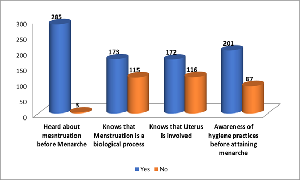Menstrual Hygiene Management Among Adolescent Girls: A Cross-Sectional Study of Practices, Perceptions, and Contextual Challenges in School Settings
Authors
##plugins.themes.bootstrap3.article.main##
Abstract
Objective: To assess the prevalence and patterns of menstrual disorders and their impact on school attendance and daily activities among rural adolescent schoolgirls in South Andaman. Design: Community-based cross-sectional study. Subjects/Patients: A total of 288 adolescent schoolgirls from the Community Health Centre Bambooflat area, South Andaman, Andaman and Nicobar Islands. Methods: Sample size was calculated using prevalence of 75% with 5% allowable error. Data were collected using a pre-tested questionnaire and analysed appropriately. Results: The vast majority (98.9%) of participants were aware of menstruation before menarche, primarily learning from their mothers (69.1%), yet significant gaps in biological knowledge persisted. While commercial sanitary pad use was predominant (94.1%), key practices like infrequent changing and non-standard disposal methods were strongly associated with poor menstrual hygiene status. Conclusion: Menstrual disorders are a significant concern among adolescent girls, underscoring the need for early identification, awareness, and supportive school-based interventions.
##plugins.themes.bootstrap3.article.details##
Copyright (c) 2025 Dr Samar Hossain, Dr Aanchal Anand, Dr Ajay Raj

This work is licensed under a Creative Commons Attribution 4.0 International License.
Creative Commons License All articles published in Annals of Medicine and Medical Sciences are licensed under a Creative Commons Attribution 4.0 International License.
Dr Samar Hossain, Assistant Professor, Department of Community Medicine, ANIIMS, Sri Vijaya Puram, Port Blair, Andaman & Nicobar Islands, India.
Assistant Professor, Department of Community Medicine, ANIIMS, Sri Vijaya Puram, Port Blair, Andaman & Nicobar Islands, India.
Dr Aanchal Anand, Assistant Professor, Department of Community Medicine, ANIIMS, Sri Vijaya Puram, Port Blair, Andaman & Nicobar Islands, India.
Assistant Professor, Department of Community Medicine, ANIIMS, Sri Vijaya Puram, Port Blair, Andaman & Nicobar Islands, India.
Dr Ajay Raj, Professor & Head, Department of Community Medicine, ANIIMS, Sri Vijaya Puram, Port Blair, Andaman & Nicobar Islands, India.
Professor & Head, Department of Community Medicine, ANIIMS, Sri Vijaya Puram, Port Blair, Andaman & Nicobar Islands, India.
[1] UNICEF. Guidance on Menstrual Health and Hygiene. UNICEF; 2019.
[2] IIPS, ICF. National Family Health Survey-5 (NFHS-5), 2019–21: India Report. IIPS; 2021.
[3] Dasgupta A, Sarkar M. Menstrual hygiene: Practices and problems among adolescent girls in a rural area of West Bengal, India. Indian J Community Med. 2008;33(3):166–9.
[4] UNESCO. Puberty education and menstrual hygiene management: good policy and practice in health education - Booklet 9. UNESCO; 2014.
[5] Budhathoki SS, Dahal M, Thapa N, Thapa T, Shrestha M. Menstrual hygiene management among adolescent girls in the rural setting of Nepal: a cross-sectional study. Reprod Health. 2018;15(1):159.
[6] Belayneh HE, Mekuriaw B. Menstrual hygiene management and its associated factors among adolescent girls in Mehal Meda, North Shoa, Ethiopia: a community-based cross-sectional study. PLoS One. 2019;14(9):e0222215.
[7] Sumpter C, Torondel B. A systematic review of the health and social effects of menstrual hygiene management. PLoS One. 2013;8(4):e62004.
[8] Sommer M, Phillips-Howard PA, Mahon T. Water, sanitation and hygiene in schools: the role of school-based education programmes in menstrual hygiene management. Waterlines. 2015;34(4):269-82.
[9] Vani KR, Veena KS, Subitha L, Kumar VRH, Bupathy A. Menstrual Abnormalities in School Going Girls – Are They Related to Dietary and Exercise Pattern? J Clin Diagn Res. 2013 Nov;7(11):2537–40.
[10] Deshpande, T. N., Patil, S. S., Gharai, S. B., Patil, S. R., & Durgawale, P. M. (2018). Menstrual hygiene among adolescent girls – A study from urban slum area. Journal of Family Medicine and Primary Care, 7(6), 1439-1445.
[11] Juyal, R., Kandpal, S. D., Semwal, J., & Negi, K. S. (2012). Practices of menstrual hygiene among adolescent girls in a District of Uttarakhand. Indian Journal of Community Health, 24(2), 124–128.
[12] Lawan, U. M., Yusuf, N. W., & Musa, A. B. (2010). Menstruation and menstrual hygiene amongst adolescent school girls in Kano, Northwestern Nigeria. African Journal of Reproductive Health, 14(3), 201-207.
[13] Davis, J., Macintyre, A., Odagiri, M., et al. (2018). Menstrual hygiene management and school absenteeism among adolescent students in Indonesia: evidence from a cross-sectional school-based survey. Tropical Medicine and International Health, 23(12), 1350-1363.
[14] Yasmin, S., Manna, N., Mallik, S., Ahmed, A., & Paria, B. (2013). Menstrual hygiene among adolescent school students: An in-depth cross-sectional study in an urban community of West Bengal, India. IOSR Journal of Dental and Medical Sciences, 5(6), 22-26.
[15] El-Gilany, A. H., Badawi, K., & El-Fedawy, S. (2005). Menstrual hygiene among adolescent schoolgirls in Mansoura, Egypt. Reproductive Health Matters, 13(26), 147-152.

